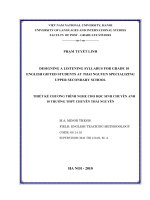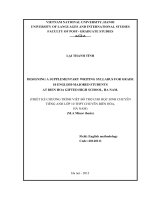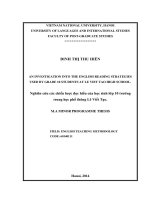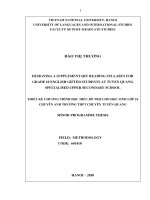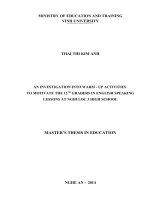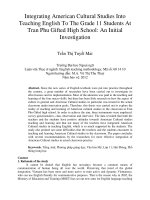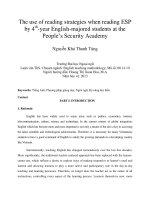An investigation into reading strategies for doing reading comprehension tests employed by grade 10 english major students at hung yen city high school
Bạn đang xem bản rút gọn của tài liệu. Xem và tải ngay bản đầy đủ của tài liệu tại đây (1.6 MB, 74 trang )
VIETNAM NATIONAL UNIVERSITY, HANOI
UNIVERSITY OF LANGUAGES AND INTERNATIONAL STUDIES
FACULTY OF POST-GRADUATE STUDIES
HOÀNG ĐỨC HẠNH
AN INVESTIGATION INTO READING STRATEGIES FOR DOING
READING COMPREHENSION TESTS EMPLOYED BY GRADE 10
ENGLISH MAJOR STUDENTS AT HUNG YEN CITY HIGH SCHOOL
NGHI N Ứ
HI Đ
NG
HI N
HI
NG H
Đ
H
PH
Đ
INH
P
NG
HI À
H I 10 CHUYÊN ANH
H NG HÀNH PH
H NG Y N
M.A. MINOR PROGRAMME THESIS
Field : English Teaching Methodology
Code : 60140111
HANOI – 2016
ÀI
VIETNAM NATIONAL UNIVERSITY, HANOI
UNIVERSITY OF LANGUAGES AND INTERNATIONAL STUDIES
FACULTY OF POST-GRADUATE STUDIES
HOÀNG ĐỨC HẠNH
AN INVESTIGATION INTO READING STRATEGIES FOR DOING
READING COMPREHENSION TESTS EMPLOYED BY GRADE 10
ENGLISH MAJOR STUDENTS AT HUNG YEN CITY HIGH SCHOOL
NGHI N Ứ
HI Đ
NG
HI N
HI
Đ
H
NG H
PH
INH
Đ
P
NG
HI À
ÀI
H I 10 CHUYÊN ANH
H NG HÀNH PH
H NG Y N
M.A. MINOR PROGRAMME THESIS
Field : English Teaching Methodology
Code : 60140111
SUPERVISOR: Assoc.Prof.Dr. NGUYỄN VĂN ĐỘ
HANOI – 2016
N I
E’
E EN
I hereby certify that the minor thesis, “An investigation into reading
strategies for doing reading comprehension tests employed by Grade 10 English
major students at Hung Yen City High School”, submitted in partial fulfillment of
the requirements for the degree of Master of Arts, is my own work.
This thesis has not been submitted for any degree to any other universities
or institutes.
Candidate‟s signature:
Dated: October 13th, 2016
HOÀNG ĐỨC HẠNH
i
ACKNOWLEDGEMENTS
I would like to express my sincere gratitude to my supervisor, Assoc. Prof.
Dr. Nguyễn Văn Độ, who helped, supported me when I conducted this study.
Without his helpful comments, valuable advice and significant assistance, this study
could not have been completed.
I would like to thank all lecturers in the Department of Post-Graduate,
University of Languages and International Studies, Vietnam National University for
their meaningful and interesting lectures.
I am grateful to Ms. Bui Nhu Hoa and her students in class 10D2 who were
always willing to join this study and provide it with valuable data.
I am indebted to Mr. Le Hai Doan, Mr. Nguyen Duc Ta, Ms. Tran Minh
Chi, Ms. Doan Mai Hoai Anh, as well as a lot of friends, relatives who constantly
encouraged and tried their best to make conditions for me to complete this thesis.
Last but not least, my special thanks must go to my Mum, my Family and
my Love for their kindest care for me and my thesis.
They are my strengths to overcome all difficulties and complete this thesis.
ii
ABSTRACT
This study reports on an evaluation of the strategies which are used in
reading comprehension tests by some English major students. Both quantitative and
qualitative data analyses are employed in the study. Forty-eight students in Grade
10 English major students at Hung Yen City High School took a three-text reading
comprehension test, followed by a 30-item questionnaire of metacognitive and
cognitive reading strategies taken in a test; then, two high-proficiency, and two lowproficiency students were invited for an interview for further information of their
actual thoughts on the reading comprehension skill and their present status of
strategies use as reading test-takers.
The results suggest that (1) metacognitive strategies and cognitive strategies
were used with medium frequency by the students; (2) the high-proficiency students
reported a higher use of both strategies than the low-proficiency students. Then, the
discussion and recommendation of strategies for better performance are also
presented.
The researcher believes that this study can be considered as a useful source
of reference for not only students but also teachers who share the same concern.
iii
LIST OF ABREVIATIONS
ESL
: English as a second language
EFL
: English as a foreign language
L2
: Second language
iv
LIST OF TABLES AND FIGURES
TABLES
Table 1. Reading strategies: definition and classification (O‟Malley & Chamot,
1990)
Table 2. Background information of the participants
Table 3. The detailed categories of strategies in Part 2 of the questionnaire
Table 4. Two major classes of reading strategies
Table 5. Descriptive statistic of eighteen sub-strategies of reading strategies
Table 6. Frequency distribution of metacognitive and cognitive reading strategies
Table 7. Difference between two groups of students in metacognitive strategies
use
Table 8. Differences between two groups of students in cognitive strategies use
Table 9. List of strategies need to be improved by the high-proficiency group
Table 10. List of strategies need to be improved by the low-proficiency group
Table 11. List of strategies should be paid attention by the low-proficiency group
FIGURES
Figure 1. The definition of reading by Anderson (2008)
Figure 2. The importance of reading comprehension compared to Ss‟ purpose
Figure 3. The students‟ evaluation of difficult levels
Figure 4. The evaluation of some factors influencing reading comprehension
performance
Figure 5. CALLA instructional framework
v
TABLE OF CONTENTS
CANDIDATE‟S STATEMENT ............................................................................... i
ACKNOWLEDGEMENTS .................................................................................... II
ABSTRACT ......................................................................................................... III
LIST OF ABREVIATIONS .................................................................................. IV
LIST OF TABLES AND FIGURES ....................................................................... V
PART I – INTRODUCTION ................................................................................... 1
1. Rationale of the study ......................................................................................... 1
2. Aims of the study................................................................................................ 2
3. Scope of the study .............................................................................................. 3
4. Significance of the research ................................................................................ 3
5. Methods of the study .......................................................................................... 3
6. Design of the study ............................................................................................. 3
PART II – DEVELOPMENT .................................................................................. 5
CHAPTER 1: LITERATURE REVIEW.................................................................. 5
1.1 Reading and Reading comprehension ................................................................ 5
1.1.1 What is reading....................................................................................... 5
1.1.2 What is reading comprehension .............................................................. 6
1.2 Strategies, reading strategies and classifications of reading strategies ............... 7
1.2.1 What are strategies ................................................................................. 7
1.2.2 What are reading strategies ..................................................................... 7
1.2.3 Classifications of reading strategies ........................................................ 8
1.3 Previous studies on strategies for reading comprehension tests in Vietnam and
in other countries............................................................................................. 12
1.3.1 Previous studies on strategies for reading comprehension tests in
Vietnam
………………………………………………………………………….12
vi
1.3.2 Previous studies on reading strategies for reading comprehension tests
for reading comprehension tests in other countries................................ 13
1.4. Summary ........................................................................................................ 14
CHAPTER 2: METHODOLOGY ......................................................................... 16
2.1 Research questions .......................................................................................... 16
2.2 Participants and settings of the study ............................................................... 16
2.2.1 Participants ................................................................................................. 16
2.2.2 Settings of the study .................................................................................... 18
2.3 Instruments ..................................................................................................... 18
2.3.1 A three-text reading comprehension test ............................................... 18
2.3.2 A questionnaire..................................................................................... 19
2.3.3 An interview ......................................................................................... 20
2.4 Data collection procedure ................................................................................ 21
2.4 Summary ......................................................................................................... 21
CHAPTER 3: FINDINGS AND DISCUSSION .................................................... 22
3.1 Findings ......................................................................................................... 22
3.1.1 The questionnaire ................................................................................ 22
3.1.2 The interview with the students ............................................................ 31
3.2 Discussion about the research questions .......................................................... 32
3.2.1 To what extent are reading strategies for doing reading comprehension
tests used by Grade 10 English major students at Hung Yen City High
School? ………………………………………………………………...32
3.2.2 To what extent do the high-proficiency students and low-proficiency
students differ in terms of employing reading strategies in reading
comprehension tests? ............................................................................ 33
3.3 Summary ......................................................................................................... 34
PART III – CONCLUSION .................................................................................. 35
1. Conclusion ........................................................................................................ 35
2. Recommendations ............................................................................................. 36
2.1 Strategies that each group of students need to improve .............................. 36
2.2 Reading strategies training ........................................................................ 38
vii
3. Limitations and suggestions for further research ............................................... 41
3.1 Limitations ………………………………………………………………...41
3.2 Suggestions for further research ................................................................ 41
REFERENCES ...................................................................................................... 43
APPENDIX 1: Reading comprehension tests………………………………………..I
APPENDI 2: Questionnaire……………………………………………………...VII
APPENDI 3: Interview………………………………………………………...XVII
APPENDIX 4: Transcription of the interviewer‟s response………..………… XVIII
viii
PART I – INTRODUCTION
1.
Rationale of the study
Thanks to its worldwide popularity and importance, English has been at the
top among the most popular foreign languages taught in schools of numerous
countries all over the world. The Vietnamese education system is not an exception
where English has been a compulsory subject from primary schools, secondary
schools, high schools, to universities, and even higher education in most sixty three
provinces nationwide.
In Vietnam‟s context, English is taught and learned in a non-native
environment; therefore reading skill has been considered as the most vital one to be
mastered, as a key of getting knowledge as well as a means of further study.
Reading comprehension tests in English are familiar with students during
their school life, especially those at high schools because most national standardized
tests still keep the grammar- and reading-based format, and reading comprehension
accounts for a large part in important national examinations including graduation
and university entrance ones.
High school students whose major subject is English in general long for
having good results in English tests, therefore they always desire to pass reading
comprehension tests with flying colors. It is also true for Grade 10 English major
students at Hung Yen City High School. However, their results of the reading
comprehension tests, or their performance in these tests still do not meet the
expectation of both students and teachers.
In search of a remedy for the situation, strategies used by students in the
reading comprehension tests have been taken into great consideration by the
researcher. According to Zhang (2011), “the strategies used during tests should be
looked at when researchers are attempting to explain variation in a specific
language test performance because they (the strategies) are directly related to test
score variation.” (p.136)
1
In contrast to numerous research conducted on investigating reading and the
strategies applied for reading comprehension with the works of Cohen (1991),
Hosenfeld (1984), Carrell (1999), the investigations into what students are actually
doing during the reading comprehension tests, that is, the strategies used under testtaking environment, are not so popular, especially in Vietnam context. In other
words, strategies in reading comprehension tests are still open for Vietnamese
educators and/or researchers.
In addition, the researcher has taught high school students for several years,
and been aware of difficulties of students while doing reading comprehension tests.
Especially for students whose major is English, it is by far important for them to
fully master the strategies for passing reading comprehension tests with the highest
scores. Therefore, the researcher intends to explore the current strategies use of
Grade 10 English major students at Hung Yen City High School employing for
doing English reading comprehension tests, as well as finds out the differences
among the strategies used by students of higher reading ability and those of lower
reading ability, namely, high and low proficiency students. Based on the findings
and searching, the researcher will make some recommendations to improve the
students‟ reading comprehension results.
For all reasons mentioned above, the researcher decides to work on a study
in the name of “An investigation into reading strategies for doing reading
comprehension tests employed by Grade 10 English major students at Hung Yen
City High School”
2. Aims of the study
The present study attempts to study the current status of reading strategies use
for doing reading comprehension tests among Grade 10 English major students at
Hung Yen City High School. To be more specific, this study is expected to achieve
the two primary aims:
2
(i)
To investigate the reading strategies employed by the students of Grade 10
English major at Hung Yen City High School for doing reading
comprehension tests; and
(ii)
To investigate the difference in terms of strategies use between the two
groups of the high- and low- proficiency students;
3. Scope of the study
Strategies employed by the reading test-takers are such a broad topic that
the researcher cannot discuss all the related aspects. Therefore, within the
framework of a minor thesis, this study focuses on the metacognitive and cognitive
reading strategies employed for doing reading comprehension tests by Grade 10
English major students at Hung Yen City High School.
4. Significance of the research
The research was carried out with the hope that the results of the study will
provide deeper insights into the nature of what the students are actually doing while
taking their English reading comprehension tests. This may lead to suggestions for
improving their results of reading comprehension tests as well as making it less
difficult for the students when taking this kind of tests in their ongoing study.
5. Methods of the study
This study was conducted as a descriptive study that utilized both
quantitative and qualitative approaches. The quantitative analysis was employed
through the process of data collected from a written questionnaire. In addition, the
qualitative approach was used to deal with the data collected from a structured
interview to examine the differences between the high and low proficiency students
in their reading strategies. The combination of these data collection methods would
help the researcher achieve the aims of the study.
6. Design of the study
This study has three main parts: Introduction, Development, and
Conclusion.
3
PART I – INTRODUCTION: briefly states the rationale of the study, the aims,
the scope, the significance, the method and the design of the study.
PART II – DEVELOPMENT: contains three chapters:
CHAPTER 1: LITERATURE REVIEW: provides a review of literature on
reading, reading comprehension, strategies, cognitive and metacognitive strategies;
and a review on previous studies on reading strategies for reading comprehension
tests in reading comprehension tests will come at the end of this chapter.
CHAPTER 2: METHODOLOGY: contains the core part of the study including
the context of the study, the methodology, the collection and the analysis of the data
for the research.
CHAPTER 3: FINDINGS & DISCUSSION: mentions the findings and
implications, the author‟s recommendations and suggestions for helping students
have better reading comprehension results.
PART III – CONCLUSION: gives a summary of the main issues that have been
discussed so far in the study and suggestions for further research.
4
PART II – DEVELOPMENT
CHAPTER 1: LITERATURE REVIEW
This chapter reviews theories related to reading and reading comprehension,
strategies, reading strategies and classifications of reading strategies. It also
summarizes some studies on reading strategies for reading comprehension tests that
have been conducted so far. All of these serve as a basis for an investigation into
reading strategies which is carried out and presented in the next chapter.
1.1
Reading and Reading comprehension
1.1.1
What is reading
Reading is an essential skill for learners of English. In fact, for most
learners it is the most important skill to master to ensure success in learning.
Anderson (2004) said that “with strengthened reading skills, second/foreign
language learners of English tend to make greater progress in other areas of
language learning.” (p.11)
Therefore, it is essential to understand what reading really is.
In 2008, the researcher wrote in his book:
“Reading can be defined simply as making meaning from print. Four key
elements combine in the process of making meaning from print: the reader, the
text, reading strategies, and fluency. Reading is a process of readers combining
information from a text and their own background knowledge to build
meaning.”(p.10)
The reader
The text
Reading
Strategies
Fluency
Figure 1. The definition of reading by Anderson (2008)
5
In addition to this view, Rubin and Thompson (1994, cited in Dao, 2007)
offered another definition which regarded reading as an “information-seeking
process” in which readers actively connect the information in the text to what they
have already known.
Mikulecky (2008) stated that “reading is a conscious and unconscious
thinking process. The reader applies many strategies to reconstruct the meaning that
the author is assumed to have intended. The reader does this by comparing
information in the text to his or her background knowledge and prior experience.”
(p.10)
The definitions of reading account for a wide range which are from simple
to complicated ones. To the researcher‟s view point, shortly, the nature of reading
appears to be not a single process; it combines all necessary interactions among the
text, the reader, the author, the strategies and the reader‟s background knowledge.
1.1.2 What is reading comprehension
Grabe (1991) claimed “comprehension is the primary purpose for reading”
(p.277). Whereas, reading comprehension can be simply understood as the ability
to get the required information from the text as efficiently as possible.
McNamara (2007) stated:
“They (some readers) may understand each word separately, but linking them
together into meaningful ideas often doesn’t happen as it should. These readers
can decode the words, but have not developed sufficient skills to comprehend the
underlying, deeper meaning of the sentences, the paragraphs, and the entire text.
Comprehension refers to the ability to go beyond the words, to understand the
ideas and the relationships between ideas conveyed in a text.” (p.1)
It is obvious from this opinion that reading comprehension is not easy; it is
really challenging, instead.
Swam (1975, p.1, cited in Le (2008)) shared his point that when a student is
claimed to be “good at comprehension”, it equally means that he can read
accurately and efficiently, so as to get the “maximum information” a text with the
“minimum of understanding.”
6
To sum up, reading comprehension is much more than just pronouncing
words correctly or simply knowing what the author intends. It is a process in which
the readers (as they read) can recognize the form and understand the relation
between the writing and the meaning.
1.2 Strategies, reading strategies and classifications of reading strategies
1.2.1 What are strategies
The word “strategy” is defined simply in the Merriam Webster Online
Dictionary as 1. a careful plan or method for achieving a particular goal usually
over a long period of time, 2. the skill of making or carrying out plans to achieve a
goal.
In the language learning context, Anderson (2004) regarded strategies as the
“conscious actions” taken by learners to improve their language learning. According
to this researcher, strategies are not a separate action, they are “a process of
orchestrating more than one action” to accomplish an L2 – second language –
reader in their selection and use.
Oxford (1990) suggested a widely accepted definition of language learning
strategies. She claimed “Learning strategies are specific actions taken by the learner
to make learning easier, faster, more enjoyable, more self-directed, more effective
and more transferable to new situations” (p.5)
Students who were better in their language performance generally reported
higher levels of overall strategy use and frequent use of a greater number of strategy
categories (Green & Oxford, 1995, p.265, cited in Song, 2005).
Therefore, when a student succeeds in applying strategies in their learning,
he/she is likely to have more advantages than others who do not hold any strategies
1.2.2 What are reading strategies
In a review of the developments in second language reading research,
Grabe (1991) pointed out that the crucial importance of the reading skill in
academic contexts had led to considerable research on reading in a second language.
And reading strategies are also of interest for what they reveal about the way the
7
readers manage their interaction with written text and how these strategies are
related to text comprehension.
Carrell (1998) defined reading strategies as “actions that readers actively
select and control to achieve desired goals or objectives” (p.1)
This researcher also agreed with Paris, Waslk, and Turner (1991, cited in
Carrell):
“…strategies are actions selected deliberately to achieve particular goals. An
emerging skill can become a strategy when it is used intentionally. Likewise, a
strategy can "go underground" [in the sense of Vygotsky, 1978] and become a
skill. Indeed strategies are more efficient and developmentally advanced when
they become generated and applied automatically as skills.” (p.611)
Whilst, reading strategies can be understood as the special thoughts or
behaviors that individuals use to help them to comprehend, learn and retain new
information from the reading text. These strategies are both observable and
unobservable and individually different.
The definitions, though worded differently, come to a common point that
the reading strategies are taken consciously by the readers to make a text‟s meaning
understood.
1.2.3
Classifications of reading strategies
Second language researchers have spent much time studying language
learning strategies. Cohen (1990), O‟Malley and Chamot (1990), and Oxford (1990)
have provided different classifications of learning strategies. The reading strategies
which will be studied in this paper are based on O‟Malley and Chamot‟s learning
strategies. Thus, O‟Malley and Chamot‟s (1990) classification will be focused on.
Regarding Cohen‟s (1990), this researcher considered the purposes of using
strategies, and classified second language learner strategies into two types: language
learning strategies (i.e. strategies used to learn a language) and language use
strategies (i.e. strategies are adopted by learners in order to use a language).
8
Whereas, Oxford (1990) proposed that the language learning strategies can
be divided into direct and indirect groups. Among them, memory strategies,
cognitive strategies and compensation strategies are classified into direct strategies,
whereas metacognitive strategies, affective strategies and social strategies belong to
indirect strategies.
For O‟Malley and Chamot (1990), they thought that learning strategies are
mental and social processes, so they divided the learning strategies into three main
branches, namely, metacognitive, cognitive and social-affective language.
In this study, only metacognitive strategies and cognitive strategies are
evaluated, social-affective strategies will be neglected because the latter is not as
closely related to reading comprehension performance as the former ones.
1.2.3.1 Metacognitive strategies
Metacognitive strategies are “higher order executive skills that may entail
planning or, monitoring, or evaluating the success of a learning activity” (Oxford,
1990, p.44). The metacognitive learning strategies identified into seven categories
by O‟Malley and Chamot (1990, p.119) and all of them are applicable to a variety
of learning tasks.
1.2.3.2 Cognitive strategies
Cognitive strategies are “more directly related to individual learning tasks
and entail direct manipulation or transformation of the learning material” (Oxford,
1990, p.8). According to O‟Malley and Chamot (1990, p.119), the cognitive
learning strategies are identified in fourteen categories. However, those cognitive
strategies may be limited in application to the specific type of task in the learning
activity.
The table below encompasses the 2 main types of strategies with their subcategories as well as the definition of the sub-categories.
9
Table 1. Reading strategies: definition and classification (O’ alley & hamot, 1990)
READING STRATEGY
DEFINITION
A. METACOGNITIVE
STRATEGIES
Planning
Previewing the main ideas and concepts of the
Advanced organizers
material to be learned, often by skimming the
text for the organizing principle.
Directed attention
Deciding in advance to attend in general to a
learning task and to ignore irrelevant distracters.
Planning
Functional planning
for
and
rehearsing
linguistic
components necessary to carry out an upcoming
task.
Deciding in advance to attend to specific aspects
Selective attention
of input, often by scanning for key words,
concepts and/or linguistic markers.
Understanding the conditions that help one learn
Self-management
and arranging for the presence of those
conditions.
Monitoring
Checking one‟s comprehension during listening
Self-monitoring
or reading or checking the accuracy and/or
appropriateness of
one‟s oral
or
written
production while it is taking place.
Evaluation
Self-evaluation
Checking the outcomes of one‟s own language
against a standard after it has been completed.
B.COGNITIVE STRATEGIES
Resourcing
Using target language reference materials such
10
as dictionaries, encyclopedias, or textbooks.
Repetition
Grouping
Imitating a language model, including overt
practice and silent rehearsal.
Classifying words, terminology or concepts
according to their attributes or meaning.
Applying rules to understand or produce the
Deduction
second language or making up rules based on
language analysis.
Imagery
Auditory representation
Using visual images (either mental or actual) to
understand or remember new information.
Planning back in one‟s mind the sound of a
word, phrase or longer language sequence.
Remembering a new word in the second
language by:
(1) identifying a familiar word in the first
Key word method
language
that
sounds
like
or
otherwise
resembles the new word, and
(2) generating easily recalled images of some
relationship with the first language homonym
and the new word in the second language.
Relating new information to prior knowledge,
Elaboration
relating different parts of new information to
each other, or making meaningful personal
associations with the new information.
Transfer
Using previous linguistic knowledge or prior
skills to assist comprehension or production.
Using available information to guess meanings
Inferencing
of new items, predict outcomes or fill in missing
information.
11
Writing down key words or concepts in
Note taking
abbreviated verbal, graphic or numerical form
while listening or reading.
Making a mental, oral or written summary of
Summarizing
new information gained through listening or
reading.
Constructing a meaningful sentence or larger
Recombination
language
sequence
by
combining
known
elements in a new way.
Using the first language as a base for
Translation
understanding and/or producing the second
language.
1.3
Previous studies on strategies for reading comprehension tests in
Vietnam and in other countries
1.3.1
Previous studies on strategies for reading comprehension tests in
Vietnam
As far as the researcher‟s concern, the research on strategies in general and
reading strategies in particular are quite popular, especially research served as the
means to complete thesis dissertation. Some of the notable research can be listed
including A study on English reading strategies employed by second year bridge
and road students university of transport and communications (Nguyen, Thi Thu
Ha, 2006) in which the researcher tried to figure out the strategies employed by the
22 students to deal with reading in English, or Reading strategies to improve
reading comprehension of students at Thai Nguyen college of economics and
technology (Nguyen, Thi Lap, 2010) with 30 respondents who were first year nonEnglish majors, this research aimed to solve the difficulties faced by the students to
achieve better results in reading comprehension.
12
It is obvious that the strategies for doing reading comprehension tests have
not been paid sufficient attention by the Vietnamese researchers. During the time of
doing literature review for this study, only one study of The strategies used in
multiple-choice tests by EFL high school students (Nguyen, Thanh Duc et al., 2012)
was found out and then processed thoroughly by the researcher. This one was
implemented with the help of 131 high-school students from Vinh Long City. The
students or respondents involving in answering a 30-item questionnaire related to
the metacognitive strategies, the cognitive strategies and compensation strategies.
The result showed that the metacognitive strategies as well as cognitive strategies
were used in an above-average level, whereas the compensation ones were highly
used. And another conclusion drawn was that the more frequently the students used
the strategies, especially metacognitive strategies, the higher their scores were.
1.3.2
Previous studies on reading strategies for reading comprehension tests
for reading comprehension tests in other countries
In contrast to a modest number of studies on reading strategies for reading
comprehension tests in Vietnamese context, this aspect of research has received
worldwide attention some decades ago.
There have been a number of studies related to strategies in language
testing since 1990 such as Anderson, Bachman, Perkins, and Cohen (1991), Block
(1992), Purpura (1997), Purpura (1998), Phakiti (2003), Zhang (2006), and Zhang
(2011).
Moreover, the foreign researchers even carried out studies on strategies
used by test-takers on various different purposes consisting of test validation
purposes, test-wiseness to validate tests, language proficiency evaluation, and
strategy instruction for performance on high-skates standardized tests. After
comparing the scope of this thesis, the researcher would like to review in more
details of the research on language proficiency related to strategies used by testtakers.
13
Purpura (1997) had a total of 1,382 test-takers from 17 language centers in
Spain, Turkey, and the Czech Republic answer an 80-item cognitive and
metacognitive strategy questionnaire, then take a 70-item standardized language
test. Purpura used structured modeling to examine the relationship between strategy
use and second language test performance (SLTP) with high- and low- proficiency
test takers. The results indicated that cognitive strategies (i.e. comprehension,
memory and retrieval strategies) are directly and positively related to test
performance. Metacognitive strategies (i.e. assessing the situation, monitoring, selfevaluation and self-testing) are significantly correlated with each other. Besides,
Purpura also found that successful and unsuccessful performers invoke strategies
differently.
Phakiti (2003), through the use of an 85-item, multiple-choice EFL reading
achievement test, followed by a cognitive and metacognitive questionnaire on how
students thought while completing the test, and an interview, investigated the
relationship between 384 Thai learners‟ cognitive and metacognitive strategy use
and their reading test performance. The test-takers completed the test first and
immediately after the test completion, they answered the questionnaire on the
degree of their strategy use during the test taking. Then eight students (four highly
successful and four unsuccessful) were invited for an interview. The result
suggested that (1) the use of cognitive and metacognitive strategies had a positive
relationship to the reading test performance; (2) the underlying factor in the use of
cognitive and metacognitive strategies could be metacognitive competence; and (3)
highly successful students reported significantly higher metacognitive strategy use
than moderate successful students who in turn reported higher use of these
strategies than unsuccessful students.
1.4. Summary
This chapter has reviewed related theories on reading and reading
comprehension, strategies, reading strategies and classifications of reading
strategies. Some of the main points can be summarized below.
14
The first main point is that the classification of learning strategies is also a
complex work done by a considerable number of researchers. Of these schemes,
O‟Malley and Chamot's has been most useful and generally accepted to date. In
O‟Malley and Chamot's framework, three major types including metacognitive,
cognitive and social/affective strategies are distinguished in accordance with the
information processing model, on which their research is based. Such a detailed and
sufficient classification of learning strategies is presented in table 1 and is going to
be adopted for the investigation of reading strategies for this study.
The second main point of this chapter covers the important theories related to
reading and an overview of studies on reading strategies of successful and
unsuccessful learners, as well as studies on metacognitive, or cognitive reading
strategies.
The next chapter is the study on reading strategies used by the EBR students,
which has been conducted in the light of the theories discussed above.
15


